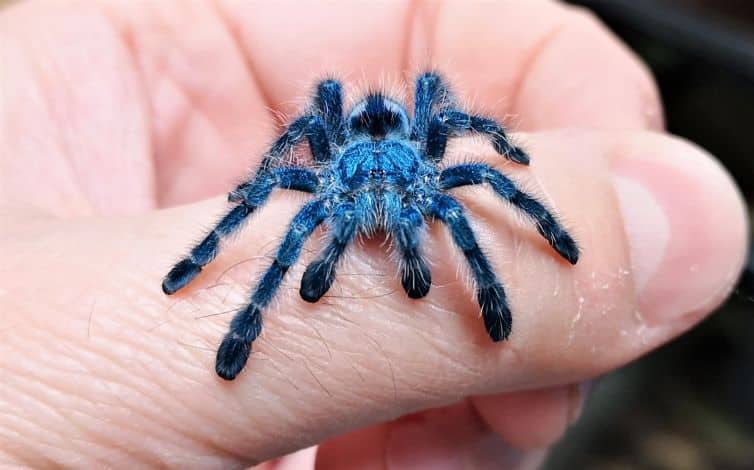The Antilles Pinktoe Tarantulas, a creature with a name as colorful as its personality, is a spectacle in the world of arachnids. Their vibrant appearance and unique characteristics make them a favorite among spider enthusiasts and a subject of fascination for many. In this article, we’ll delve into the world of the Antilles Pinktoe Tarantula, exploring its habitat, behavior, and the striking purple variety that captures the imagination.
Understanding the Antilles Pinktoe Tarantula
The Antilles Pinktoe Tarantula (Avicularia versicolor), also known as the Martinique Red Tree Spider, is native to the Caribbean, specifically the islands of Guadeloupe and Martinique. This species belongs to the family Theraphosidae and is known for its distinctive pinkish toes and the metallic green to blue sheen on its body.
The Allure of the Purple Antilles Pinktoe Tarantula
One of the most striking variations of this species is the Purple Antilles Pinktoe Tarantula. This rare color morph exhibits a deep, vibrant purple hue over its body, making it a highly sought-after specimen in the pet trade. The purple coloration is most prominent in juveniles and tends to fade into a more metallic sheen as the tarantula matures.
Size and Appearance
The Antilles Pinktoe Tarantula is a medium-sized tarantula, with adult females reaching a leg span of approximately 5 inches (12.7 cm), while males tend to be slightly smaller. They possess a velvety appearance due to their fine urticating hairs, which they use as a defense mechanism against predators.
Antilles Pinktoe Tarantula Habitat
In the wild, Antilles Pinktoe Tarantulas are arboreal, living in the trees of tropical rainforests. Their habitat is characterized by high humidity and moderate temperatures, typically ranging from 75°F to 85°F (24°C to 29°C).
Living Among the Trees
These tarantulas create silken retreats in the crevices of tree bark or among dense foliage, where they spend most of their time. The webbing provides a secure home and serves as a place to molt, lay eggs, and catch prey.
Captive Care and Terrarium Setup
For those who keep Antilles Pinktoe Tarantulas as pets, replicating their natural habitat is crucial. A well-ventilated terrarium with plenty of vertical space for climbing is essential. Decor such as cork bark, branches, and live or artificial plants help create an environment that closely resembles their natural surroundings.
Diet and Feeding Habits
Antilles Pinktoe Tarantulas are opportunistic feeders, preying on a variety of insects such as crickets, moths, and small beetles. In captivity, a diet of gut-loaded crickets and occasional mealworms or small roaches will keep them healthy and well-fed.
Feeding Schedule
Juvenile tarantulas should be fed more frequently, about 2-3 times a week, while adults can be offered food once a week. It is important to remove any uneaten prey after 24 hours to prevent stress and potential harm to the tarantula.
Behavior and Temperament
The Antilles Pinktoe Tarantula is known for its docile nature, making it a popular choice for tarantula keepers. Unlike some other tarantula species, they are less likely to show aggression and are generally tolerant of handling. However, caution should always be exercised, as they can become stressed and may jump or release urticating hairs if they feel threatened.
Social Interaction
While most tarantulas are solitary, the Antilles Pinktoe has been observed exhibiting semi-social behavior. In the wild, juveniles can sometimes be found living in close proximity, and captive juveniles may even cohabitate peacefully for a time. It is crucial, however, to monitor them closely as they grow to prevent possible cannibalism.
Reproduction and Lifespan
The reproductive process for Antilles Pinktoe Tarantulas begins with a courtship dance, where the male taps and vibrates his body to signal his intentions to the female. After mating, the female will lay an egg sac that can contain upwards of 100 eggs.
Maturation and Lifespan
Males typically reach maturity faster than females and have a shorter lifespan, living only about 2-3 years after maturation. Females, on the other hand, can live for a decade or more with proper care.
Conservation Status
The Antilles Pinktoe Tarantula is not currently listed as an endangered species; however, like many animals native to small island ecosystems, they could be at risk due to habitat destruction and the pet trade. Sustainable and ethical practices are essential for ensuring the continued survival of these fascinating creatures in the wild.
The Role of Captive Breeding
Captive breeding programs play a significant role in conservation efforts. Providing an alternative to wild-caught specimens and helping to maintain genetic diversity within the species.
Common Misconceptions About Tarantulas
Despite their often intimidating appearance, tarantulas like the Antilles Pinktoe are largely misunderstood. They are not aggressive creatures and prefer to avoid confrontation. Additionally, their venom is not lethal to humans, with effects usually comparable to a bee sting in terms of pain and discomfort.
Overcoming Arachnophobia
Education and exposure to gentle species such as the Antilles Pinktoe Tarantula can help individuals overcome their fear of spiders. By learning about their behavior and ecological importance, people can develop a greater appreciation for these remarkable arachnids.
In Conclusion
The Antilles Pinktoe Tarantula is a captivating species that offers a window into the diversity and complexity of spider life. Whether you’re an arachnid aficionado or simply curious about the natural world. The Antilles Pinktoe Tarantula is a testament to the beauty and intrigue that can be found in even the smallest creatures. By understanding and respecting their needs and natural behaviors. We can ensure that these stunning spiders continue to thrive both in captivity and in the wild.
Read Also-:

